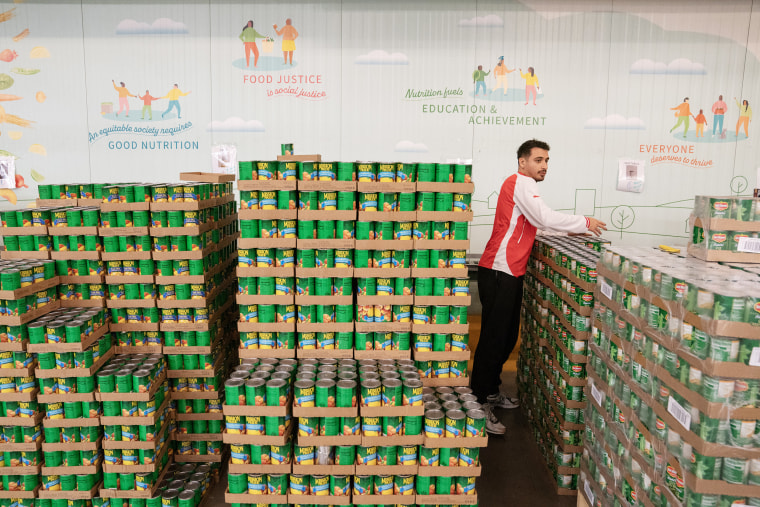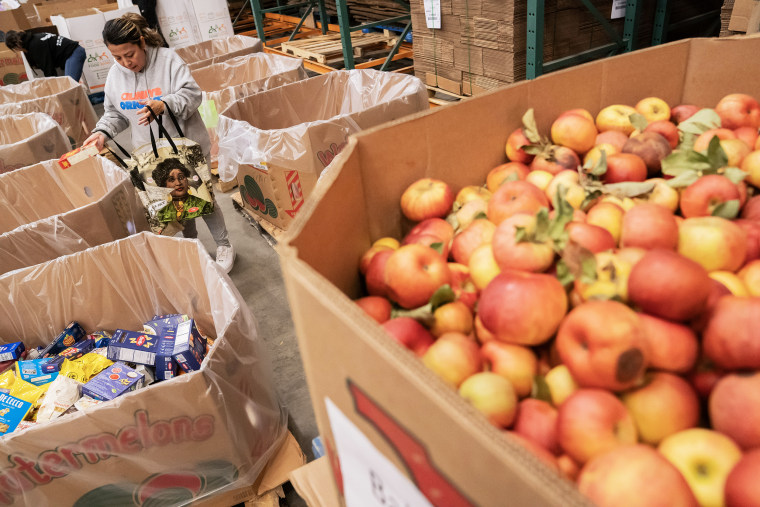With unemployment low and wages rising, the struggle for basic necessities like food should be easing. But those on the front lines of feeding the hungry say they are seeing the opposite.

A volunteer at the Capital Area Food Bank in Washington, D.C., last month. Nathan Howard / Bloomberg via Getty Images
Dec. 10, 2023
By Shannon Pettypiece
Jennifer Estrada is making more money than ever yet struggling just as much to feed her family.
For the past year, Estrada has been working 12-hour shifts overnight as a production supervisor at a Wisconsin aluminum plant, making $7 an hour more than she was a year ago. But with rent that’s more than doubled and a monthly grocery bill that now tops $2,400 for her family of seven, Estrada has been having to turn to local food banks to keep her children from going hungry.
“There are definitely many times, as a mom, where you cook and you make sure they eat and you go a little bit lighter that night,” Estrada said. “But I strive to make sure that they don’t go hungry.”
By traditional measures of the economy, where unemployment has been at historic lows and wages have been rising, more Americans should be prospering and the need for help with basic necessities like food should be easing after surging during the pandemic.
But those on the front lines of feeding the hungry say they are seeing the opposite. Instead, they say a growing number of Americans have been seeking out help from food banks and government food programs over the past year amid a perfect storm of persistently rising costs and shrinking programs to help households cope with these growing expenses.

Dec. 10, 2023
By Shannon Pettypiece
Jennifer Estrada is making more money than ever yet struggling just as much to feed her family.
For the past year, Estrada has been working 12-hour shifts overnight as a production supervisor at a Wisconsin aluminum plant, making $7 an hour more than she was a year ago. But with rent that’s more than doubled and a monthly grocery bill that now tops $2,400 for her family of seven, Estrada has been having to turn to local food banks to keep her children from going hungry.
“There are definitely many times, as a mom, where you cook and you make sure they eat and you go a little bit lighter that night,” Estrada said. “But I strive to make sure that they don’t go hungry.”
By traditional measures of the economy, where unemployment has been at historic lows and wages have been rising, more Americans should be prospering and the need for help with basic necessities like food should be easing after surging during the pandemic.
But those on the front lines of feeding the hungry say they are seeing the opposite. Instead, they say a growing number of Americans have been seeking out help from food banks and government food programs over the past year amid a perfect storm of persistently rising costs and shrinking programs to help households cope with these growing expenses.

Volunteers sort through donated food at the Capital Area Food Bank in Washington last month.
Nathan Howard / Bloomberg via Getty Images
“The demand is higher now than it ever was during the pandemic,” said Claire Babineaux-Fontenot, head of Feeding America, which works with a network of 200 food banks. “This is not just one group’s issue, it’s an American issue. Hunger is an issue in America across every demographic group, and now, growingly, across more and more levels of income.”
As of June, Feeding America had given out 5.3 billion meals over the previous 12 months.
Over the past year, nearly 1 million more people have received food assistance through the Supplemental Nutrition Assistance Program, often referred to as food stamps. Since the start of the pandemic, the number of food stamp recipients has increased by 2.3 million. Other programs, like the Supplemental Nutrition Program for Women, Infants and Children, known as WIC, have also seen record levels of enrollment, with administrators concerned they won’t have the funding next year to keep up with demand.
That comes even as unemployment has remained near historic lows, wages are rising, inflation is slowing, and consumers are spending record amounts on everything from summer travel to concert tickets and holiday shopping. President Joe Biden has touted an economic resurgence fueled by billions of federal dollars for infrastructure, clean energy and semiconductor manufacturing jobs that he has made central to his re-election pitch.
But despite those metrics, polls have repeatedly shown Americans have a dismal view of the economy and the outlook for their financial future. In a New York Times/Siena College poll released in November, 81% of registered voters characterized the economy as either “fair” or “poor.”
“The demand is higher now than it ever was during the pandemic,” said Claire Babineaux-Fontenot, head of Feeding America, which works with a network of 200 food banks. “This is not just one group’s issue, it’s an American issue. Hunger is an issue in America across every demographic group, and now, growingly, across more and more levels of income.”
As of June, Feeding America had given out 5.3 billion meals over the previous 12 months.
Over the past year, nearly 1 million more people have received food assistance through the Supplemental Nutrition Assistance Program, often referred to as food stamps. Since the start of the pandemic, the number of food stamp recipients has increased by 2.3 million. Other programs, like the Supplemental Nutrition Program for Women, Infants and Children, known as WIC, have also seen record levels of enrollment, with administrators concerned they won’t have the funding next year to keep up with demand.
That comes even as unemployment has remained near historic lows, wages are rising, inflation is slowing, and consumers are spending record amounts on everything from summer travel to concert tickets and holiday shopping. President Joe Biden has touted an economic resurgence fueled by billions of federal dollars for infrastructure, clean energy and semiconductor manufacturing jobs that he has made central to his re-election pitch.
But despite those metrics, polls have repeatedly shown Americans have a dismal view of the economy and the outlook for their financial future. In a New York Times/Siena College poll released in November, 81% of registered voters characterized the economy as either “fair” or “poor.”

Jennifer Estrada.Courtesy Jennifer Estrada
In Wisconsin, Estrada shares that pessimistic view. She said her family has struggled financially since her husband was deported to Mexico in 2012, leaving her as the sole provider for six children, including one whom she adopted. But she says the struggle has gotten even harder over the past several years, despite an increase in her income, and she worries about what the future looks like for her children, ages 10 to 18.
“For me, personally, I think it’s going to be a continual struggle, pretty much for the rest of my life, however long that may be,” said Estrada, 43, who has started a nonprofit to help other low-income families like hers and who ran unsuccessfully in 2018 as a Democrat for the Wisconsin state Assembly. “But what I’m more fearful of is that I have three girls that are graduating this year from high school, and I’m just fearful as to what the world has to offer them.”
Food has been at the center of the economic pressure points. Across all food categories, prices have gone up around 25% since 2020. Beef prices, for examples, are at record highs, with the price of ground beef topping $5 a pound, up more than a dollar over the past three years. The price for a gallon of milk, currently averaging just under $4, has ticked down in recent months but is still 20% higher than before the pandemic. The price of a loaf of white bread is up nearly 50% to $2.
While inflation has slowed in recent months and wages have been rising, at the current rate it could take until the end of 2024 before wage growth outpaces the rate of inflation, according to an analysis by Bankrate.
Amid the rising prices, more people say they are going hungry. There has been a continual uptick over the past year in the number of people reporting that they don’t have enough food at times, according to a Census Bureau survey conducted at the end of October. The number of households that said they struggled to afford food at some point during the year increased to 17 million in 2022, up 26% from 2021 — the biggest annual increase since 2008, according to a recent Department of Agriculture report.
Since having her baby nine months ago, Janet Ortigoza has been among those unable to afford the food her family needs. Ortigoza isn’t working because she’s unable to afford child care, leaving the family of three dependent on her husband’s income as an agricultural worker in the Fresno, California, region — helping produce the food his family struggles to afford.
“You used to be able to get five bags of groceries for $50, now you only get one bag for $50,” said Ortigoza. “I am honestly scared to have another baby because I don’t think we will be able to provide for another baby. Now that she’s growing, she’s going to start eating three times a day, and just trying to provide the right nutrition to her, it’s hard.”
Her husband’s most recent paycheck for seven days of work went to pay December’s rent of $840 with nothing left over for extras like food or diapers. A year ago, buying a new pair of shoes wouldn’t have seemed like a luxury, but now Ortigoza said it is a purchase she’s been putting off, along with new baby blankets.
In Wisconsin, Estrada shares that pessimistic view. She said her family has struggled financially since her husband was deported to Mexico in 2012, leaving her as the sole provider for six children, including one whom she adopted. But she says the struggle has gotten even harder over the past several years, despite an increase in her income, and she worries about what the future looks like for her children, ages 10 to 18.
“For me, personally, I think it’s going to be a continual struggle, pretty much for the rest of my life, however long that may be,” said Estrada, 43, who has started a nonprofit to help other low-income families like hers and who ran unsuccessfully in 2018 as a Democrat for the Wisconsin state Assembly. “But what I’m more fearful of is that I have three girls that are graduating this year from high school, and I’m just fearful as to what the world has to offer them.”
Food has been at the center of the economic pressure points. Across all food categories, prices have gone up around 25% since 2020. Beef prices, for examples, are at record highs, with the price of ground beef topping $5 a pound, up more than a dollar over the past three years. The price for a gallon of milk, currently averaging just under $4, has ticked down in recent months but is still 20% higher than before the pandemic. The price of a loaf of white bread is up nearly 50% to $2.
While inflation has slowed in recent months and wages have been rising, at the current rate it could take until the end of 2024 before wage growth outpaces the rate of inflation, according to an analysis by Bankrate.
Amid the rising prices, more people say they are going hungry. There has been a continual uptick over the past year in the number of people reporting that they don’t have enough food at times, according to a Census Bureau survey conducted at the end of October. The number of households that said they struggled to afford food at some point during the year increased to 17 million in 2022, up 26% from 2021 — the biggest annual increase since 2008, according to a recent Department of Agriculture report.
Since having her baby nine months ago, Janet Ortigoza has been among those unable to afford the food her family needs. Ortigoza isn’t working because she’s unable to afford child care, leaving the family of three dependent on her husband’s income as an agricultural worker in the Fresno, California, region — helping produce the food his family struggles to afford.
“You used to be able to get five bags of groceries for $50, now you only get one bag for $50,” said Ortigoza. “I am honestly scared to have another baby because I don’t think we will be able to provide for another baby. Now that she’s growing, she’s going to start eating three times a day, and just trying to provide the right nutrition to her, it’s hard.”
Her husband’s most recent paycheck for seven days of work went to pay December’s rent of $840 with nothing left over for extras like food or diapers. A year ago, buying a new pair of shoes wouldn’t have seemed like a luxury, but now Ortigoza said it is a purchase she’s been putting off, along with new baby blankets.

Janet Ortigoza.Courtesy Janet Ortigoza
While inflation has slowed, Ortigoza’s costs have continued to rise. In January, her rent will increase by nearly $100. Nationwide, rent is up nearly 30% since the pandemic began, according to Zillow.
Utilities have also been on the rise, and this year Ortigoza isn’t planning on turning on the home’s heater, even with temperatures dipping into the 30s at night. Instead, she plans to wear extra clothes around the house and bundle her daughter in blankets.
To put food on the table, she’s had to turn to local food banks along with donations from a Facebook mom group. Her family’s income is too high to qualify for food stamps, but she has been receiving WIC benefits to help pay for formula and food for her daughter.
The struggle to afford food amid rising prices has been particularly acute for those unable to work and benefit from the rising wages, either because they are retired, disabled or the full-time caregiver for a child or relative.
Over the past year, Carl Willette has started going regularly to an Augusta, Maine, food bank for the first time in his life. At 85 years old and as the full-time caregiver for his wife, Claire, he depends on $20,000 a year in Social Security benefits and a small pension from working 30 years as a mechanic for Mack Trucks.
Each Thursday at around 7:30 a.m., Willette gets in line behind at least 30 other cars at a food pantry, where he’s able to pick up a limited number of items to help get through the week.
“It is like a noose around your neck getting tighter,” Willette said. “You cannot imagine the pressure that is on us now with everything the way it is. I can’t understand, how do they justify the wages that there are today, why does stuff have to go up like that, why does it have to go up so much?”
While food banks and government programs have filled the void for many who are struggling, those resources have been dwindling. Earlier this year, food stamp benefits were cut by an average of $90 a month after a Covid-era boost to the program expired. WIC program administrators are worried their budget for next year won’t keep up with the growing need they are seeing, with enrollment increasing by around 300,000 people in 2023 to a record 6.7 million participants.
“The worst-case scenario is waitlists for participants where states may not have enough funding to meet caseload needs, which would be absolutely terrible,” said Georgia Machell, interim president of the National WIC Association. “It’s putting state programs in a really difficult position and having to make very, very difficult decisions in order to continue operating.”
Food banks have also struggled to keep up with rising demand as donations have dropped and food prices have gone up, said Feeding America’s Babineaux-Fontenot.
Anita Garrett says she’s increasingly struggling to feed her five grandchildren, whom she has been caring for since their father was killed five years ago. At 65 and disabled, she said she is unable to work, leaving her dependent on her monthly allotment of around $200 in food stamps, which was cut by nearly $100 earlier this year.
That leaves her relying on a local Milwaukee food bank as the main source of food for her family, but even there she has seen cuts. As the demand has grown, the food bank has gone from giving out two bags of groceries a week to just one bag that includes one piece of meat to last for the week.
“The boxes they are giving the people are getting smaller and smaller. But the lines are getting longer and longer,” Garrett said. “Everything is getting cut, cut, cut. Everything is going up, up, up. I feel a depression coming.”
While inflation has slowed, Ortigoza’s costs have continued to rise. In January, her rent will increase by nearly $100. Nationwide, rent is up nearly 30% since the pandemic began, according to Zillow.
Utilities have also been on the rise, and this year Ortigoza isn’t planning on turning on the home’s heater, even with temperatures dipping into the 30s at night. Instead, she plans to wear extra clothes around the house and bundle her daughter in blankets.
To put food on the table, she’s had to turn to local food banks along with donations from a Facebook mom group. Her family’s income is too high to qualify for food stamps, but she has been receiving WIC benefits to help pay for formula and food for her daughter.
The struggle to afford food amid rising prices has been particularly acute for those unable to work and benefit from the rising wages, either because they are retired, disabled or the full-time caregiver for a child or relative.
Over the past year, Carl Willette has started going regularly to an Augusta, Maine, food bank for the first time in his life. At 85 years old and as the full-time caregiver for his wife, Claire, he depends on $20,000 a year in Social Security benefits and a small pension from working 30 years as a mechanic for Mack Trucks.
Each Thursday at around 7:30 a.m., Willette gets in line behind at least 30 other cars at a food pantry, where he’s able to pick up a limited number of items to help get through the week.
“It is like a noose around your neck getting tighter,” Willette said. “You cannot imagine the pressure that is on us now with everything the way it is. I can’t understand, how do they justify the wages that there are today, why does stuff have to go up like that, why does it have to go up so much?”
While food banks and government programs have filled the void for many who are struggling, those resources have been dwindling. Earlier this year, food stamp benefits were cut by an average of $90 a month after a Covid-era boost to the program expired. WIC program administrators are worried their budget for next year won’t keep up with the growing need they are seeing, with enrollment increasing by around 300,000 people in 2023 to a record 6.7 million participants.
“The worst-case scenario is waitlists for participants where states may not have enough funding to meet caseload needs, which would be absolutely terrible,” said Georgia Machell, interim president of the National WIC Association. “It’s putting state programs in a really difficult position and having to make very, very difficult decisions in order to continue operating.”
Food banks have also struggled to keep up with rising demand as donations have dropped and food prices have gone up, said Feeding America’s Babineaux-Fontenot.
Anita Garrett says she’s increasingly struggling to feed her five grandchildren, whom she has been caring for since their father was killed five years ago. At 65 and disabled, she said she is unable to work, leaving her dependent on her monthly allotment of around $200 in food stamps, which was cut by nearly $100 earlier this year.
That leaves her relying on a local Milwaukee food bank as the main source of food for her family, but even there she has seen cuts. As the demand has grown, the food bank has gone from giving out two bags of groceries a week to just one bag that includes one piece of meat to last for the week.
“The boxes they are giving the people are getting smaller and smaller. But the lines are getting longer and longer,” Garrett said. “Everything is getting cut, cut, cut. Everything is going up, up, up. I feel a depression coming.”
Shannon Pettypiece is senior policy reporter for NBC News digital.

No comments:
Post a Comment